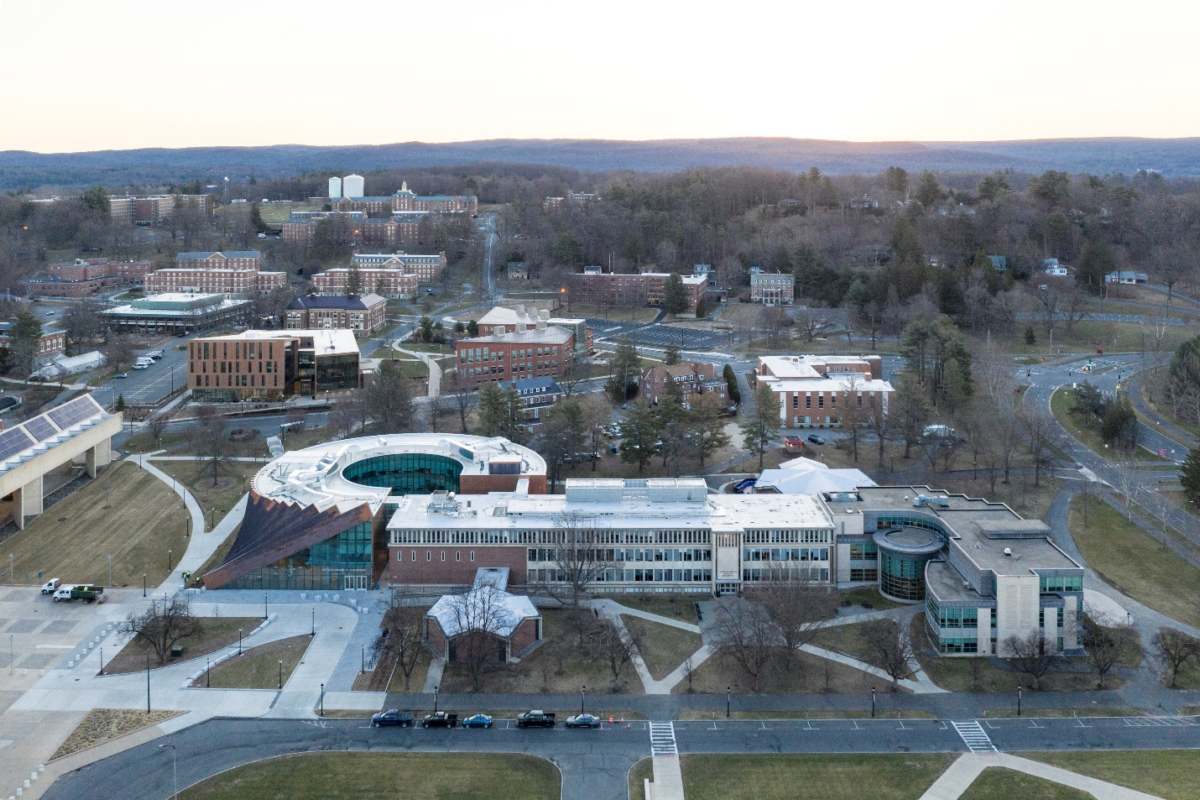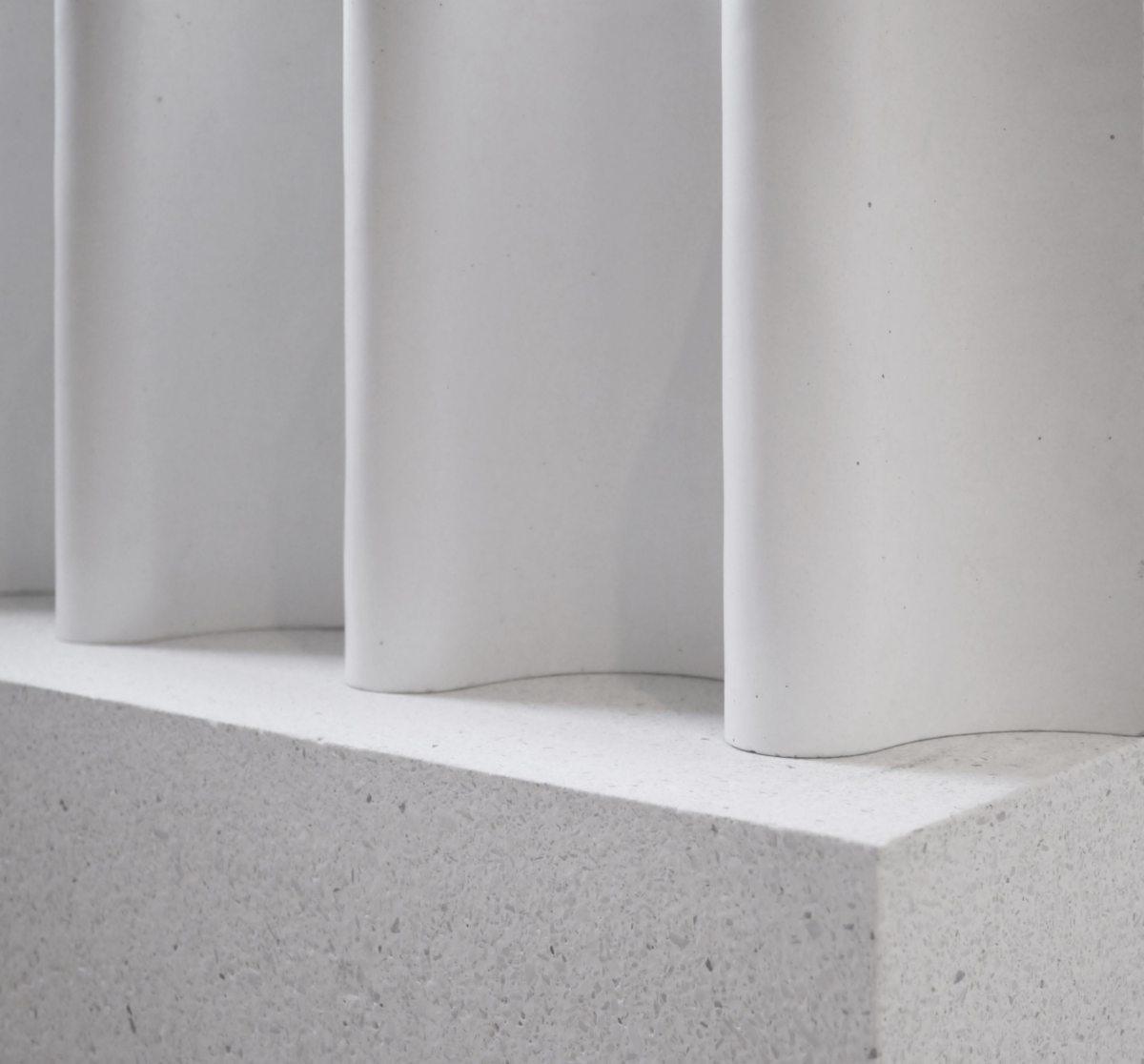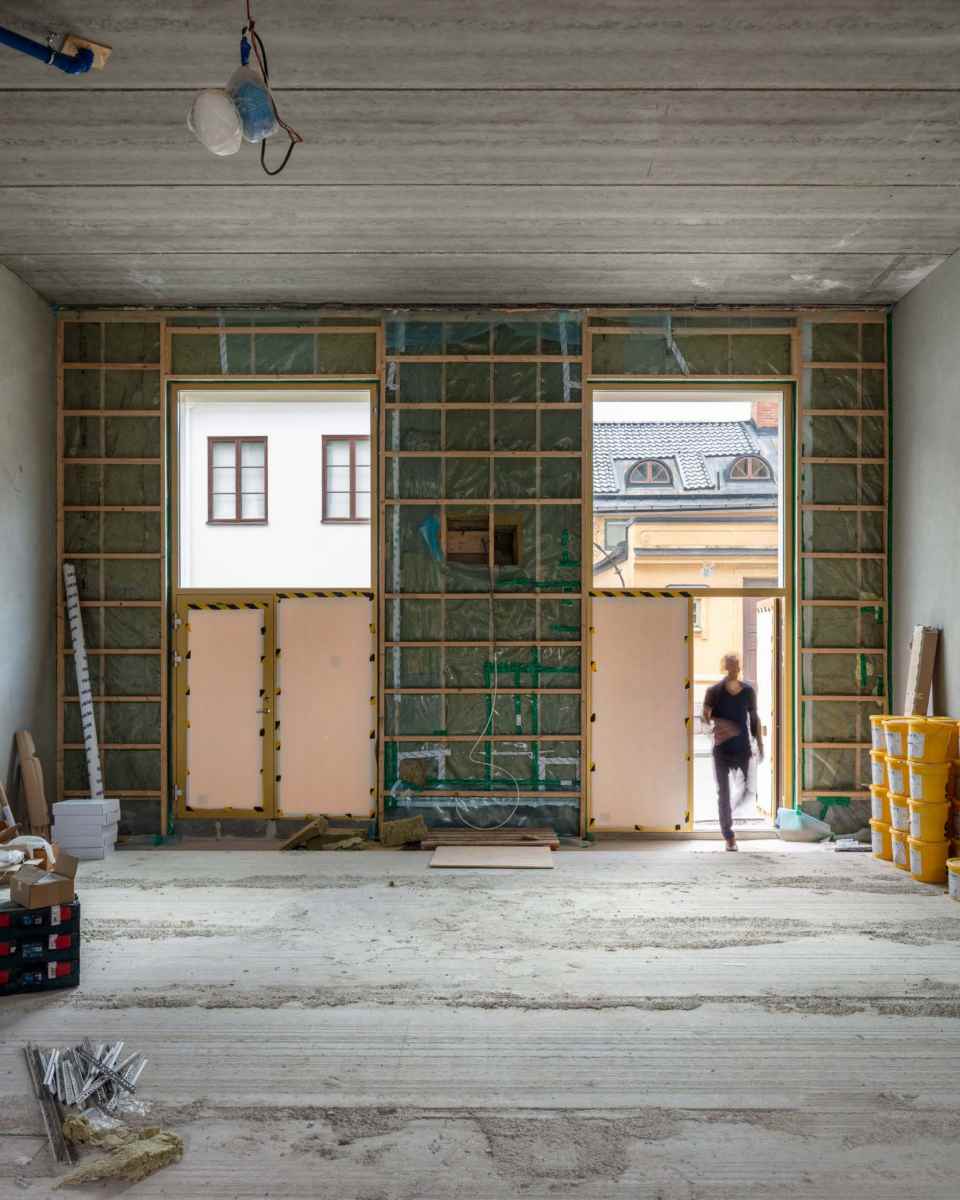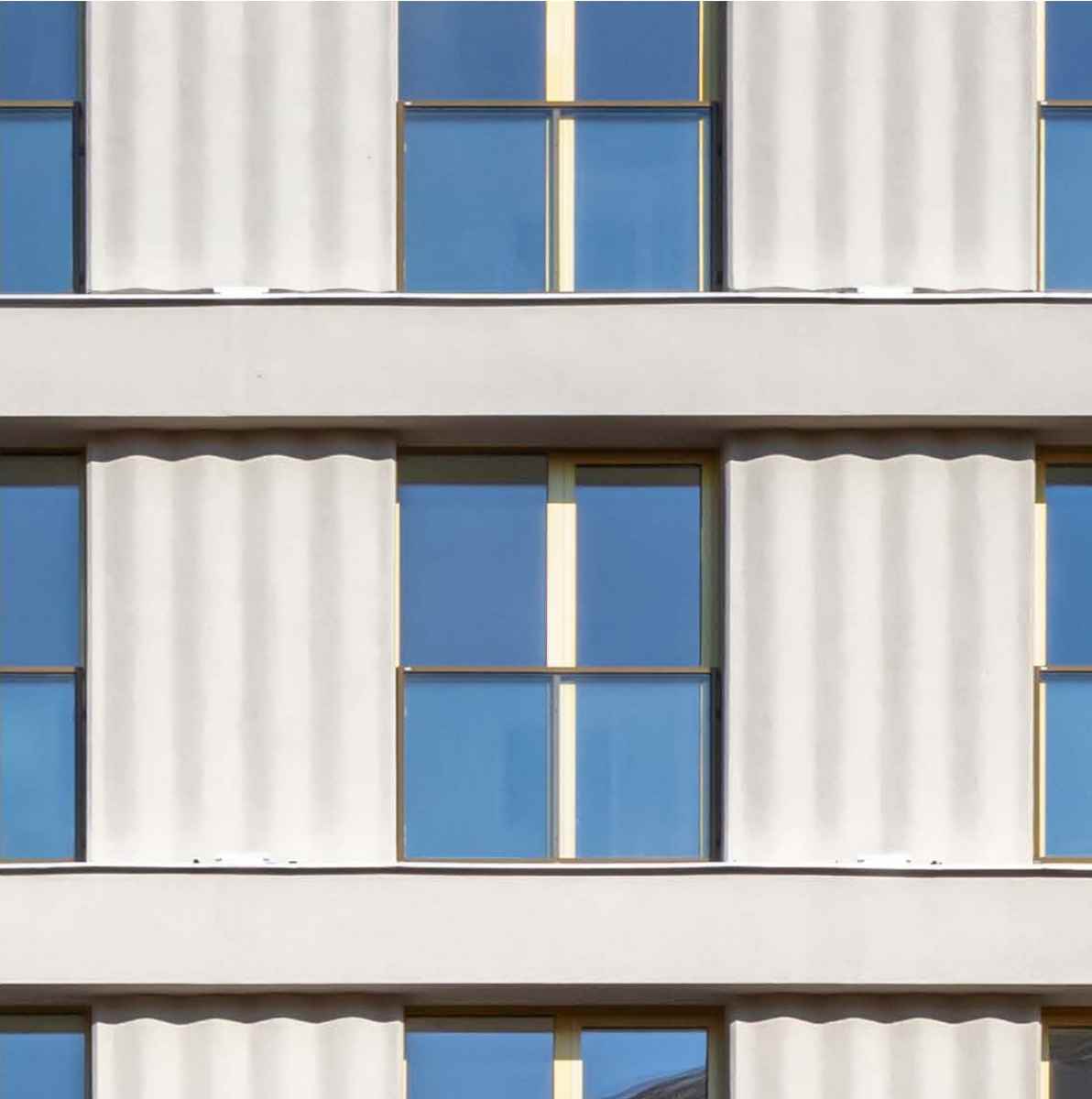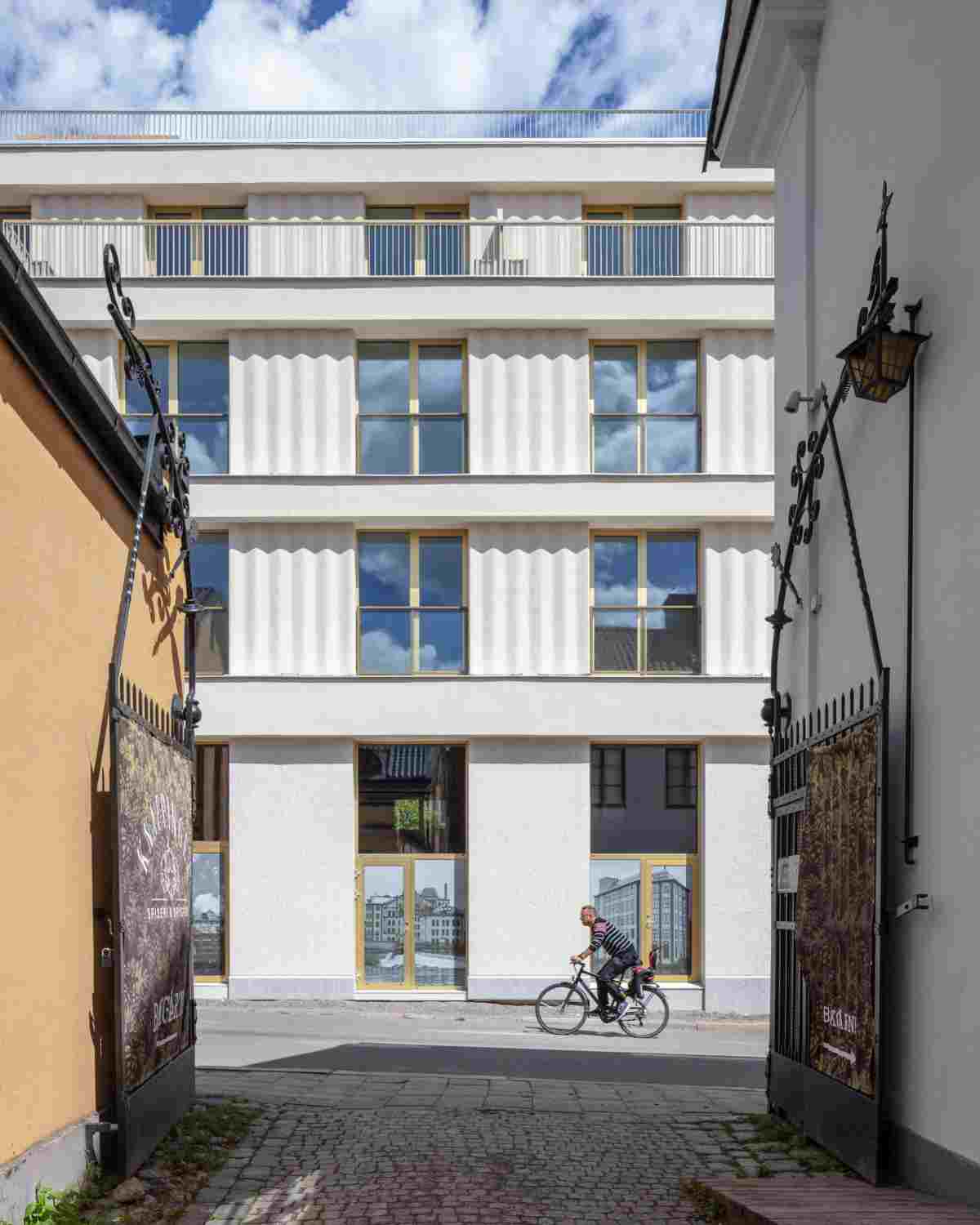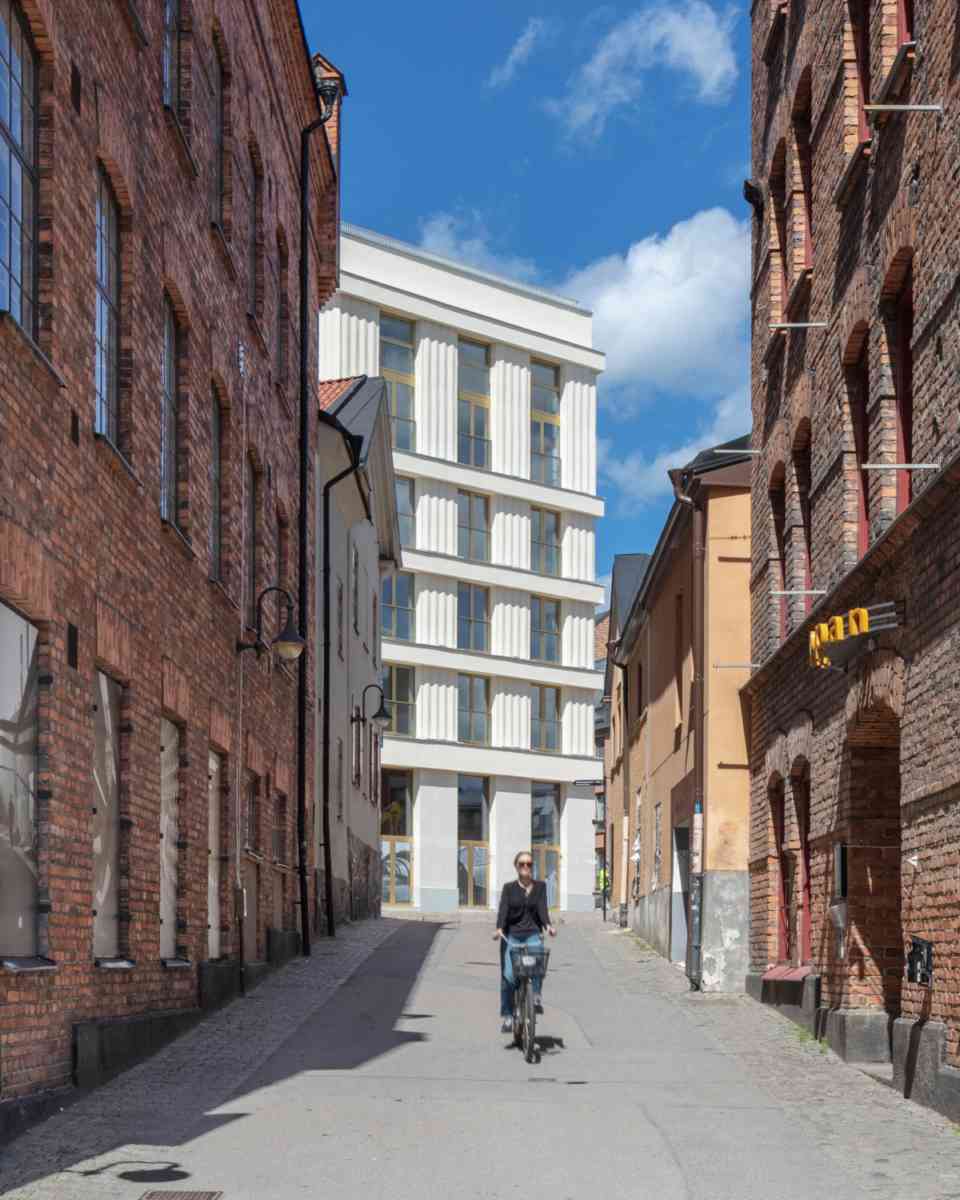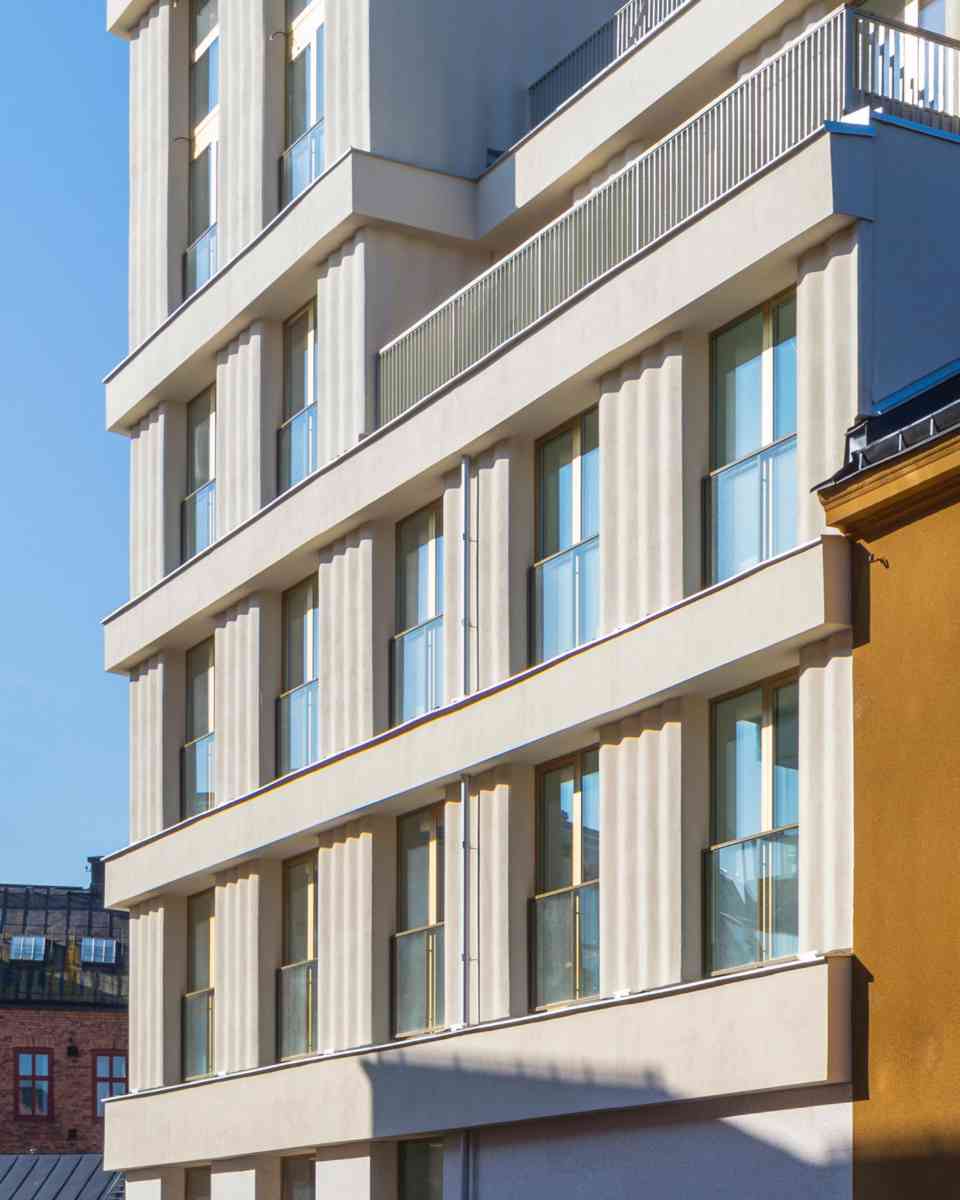Solarplan für die Schweiz
Sonne für den Klimaschutz
Ein Solarplan für die Schweiz
von Roger Nordmann
Zytglogge Verlag, Bern
1. Auflage, 2019
kartoniert, 183 Seiten
zahlreiche Abb. u. Tabellen
Größe: 21 x 14.8 cm
ISBN: 978-3-7296-5028-2
Isenberg School of Management by BIG & Goody Clancy
Designed by BIG-Bjarke Ingels Group and Architect of Record Goody Clancy, the copper-clad Business Innovation Hub at the heart of the University of Massachusetts Amherst adds 70,000SF of hyper-collaborative study and social space to one of the top-30 public business schools in the United States.
The new expansion and partial renovation of the Isenberg School of Management nearly doubles the school’s current space to accommodate Isenberg’s growth in the last decade, while introducing new facilities for more than 150 staff and 5,000 students in undergraduate, master’s and PhD programs. BIG and Goody Clancy were commissioned in 2015 to design a flexible space that inspires and facilitates collaboration for every Isenberg student.
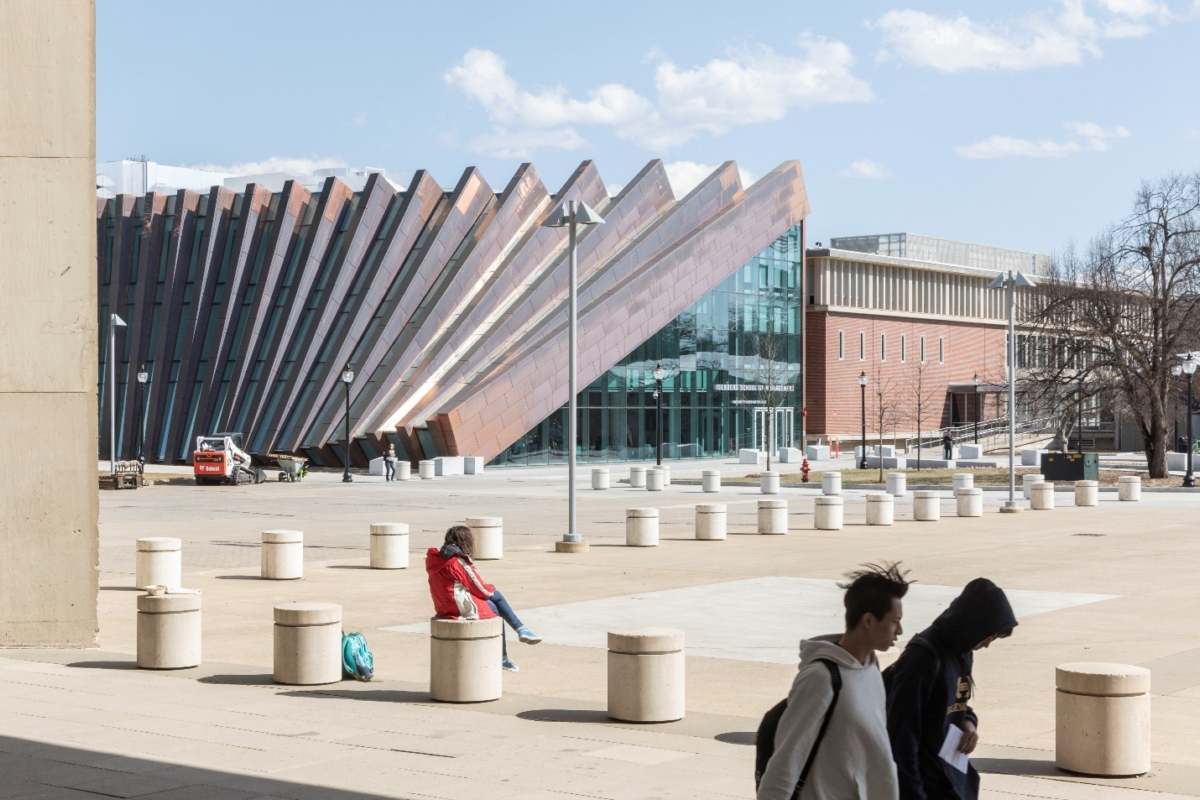 “As a top business school, we want to offer our students, faculty and staff an environment that inspires creativity, communication, innovation and collaboration—a physical space designed to train and prepare students for careers in the 21st century. The new Business Innovation Hub clearly reflects our mission and vision for the future. Equally important, with flexible spaces and state-of-the-art tools and technologies, the Business Innovation Hub will continue to meet the rapidly evolving needs of the Isenberg community.” Tom Moliterno, Interim Dean, Isenberg School of Management.
“As a top business school, we want to offer our students, faculty and staff an environment that inspires creativity, communication, innovation and collaboration—a physical space designed to train and prepare students for careers in the 21st century. The new Business Innovation Hub clearly reflects our mission and vision for the future. Equally important, with flexible spaces and state-of-the-art tools and technologies, the Business Innovation Hub will continue to meet the rapidly evolving needs of the Isenberg community.” Tom Moliterno, Interim Dean, Isenberg School of Management.Prominently situated on Haigis Mall near the entrance to the campus, a dramatic triangular glass entrance created by a domino-effect greets students. The building exterior is wrapped in straight, vertical pillars that gradually slope downward, creating a distinct appearance without any curved elements.
 The Business Innovation Hub directly extends the school’s existing 1964 building from the north and east sides in a wide circular loop, linking back on the upper floors to maintain connectivity. The loop consolidates Isenberg’s faculty and staff under one roof, creating a singular place of arrival and a strong visual identity for the entire Isenberg School of Management.
The Business Innovation Hub directly extends the school’s existing 1964 building from the north and east sides in a wide circular loop, linking back on the upper floors to maintain connectivity. The loop consolidates Isenberg’s faculty and staff under one roof, creating a singular place of arrival and a strong visual identity for the entire Isenberg School of Management. “The new Business Innovation Hub at the Isenberg School of Management is conceived as an extension of both the building and the campus mall. The linear structure is bent to form a full loop framing an internal courtyard for the life of the students. The façade is pulled away in a domino effect to create a generous invitation from the Haigis Mall to the Learning Commons. The mall and the courtyard – inside and outside form a forum for the students, the faculty and the profession to meet, mingle and mix society and academia.” Bjarke Ingels, Founder & Creative Director, BIG.
The Business Innovation Hub’s exterior is clad in copper, so long-term exposure to the elements will naturally weather the metal from a dark ochre to an enduring patina. With longevity and sustainability in mind, the building also targets LEED Silver certification.
“There’s no other building at UMass Amherst that’s going to look remotely like this. Isenberg is trying to raise its profile among peer institutions. We have no doubt this will help Isenberg attract the best and brightest faculty and students.” Roger Goldstein, Principal, Goody Clancy.
Upon entering, students and faculty arrive at the 5,000SF Learning Commons. Daylight peers between the accordion-like pillars to illuminate the multi-story atrium, where the heart of the business school hums with students learning, networking and dining.
The bright and spacious Learning Commons doubles as an event venue for guest speakers, award ceremonies, banquets and career fairs. In any room or hallway, natural light reaches inside from both the campus and the inner courtyard.
 Throughout the Business Innovation Hub, spaces are designed with student interactions, teamwork and chance encounters in mind: soft chairs adorn the corridors, benches are affixed to the grand stairway and classroom chairs can easily maneuver for theater-style lectures or small group work.
Throughout the Business Innovation Hub, spaces are designed with student interactions, teamwork and chance encounters in mind: soft chairs adorn the corridors, benches are affixed to the grand stairway and classroom chairs can easily maneuver for theater-style lectures or small group work.On the second and third floors, students and staff occupy the innovation labs, advising spaces and faculty offices. To support the career development of every Isenberg student, classrooms are equipped with integrated technology for distance learning. In addition, the Chase Career Center gains 15 new interview rooms, and various conference rooms and breakout areas are distributed throughout the loop.
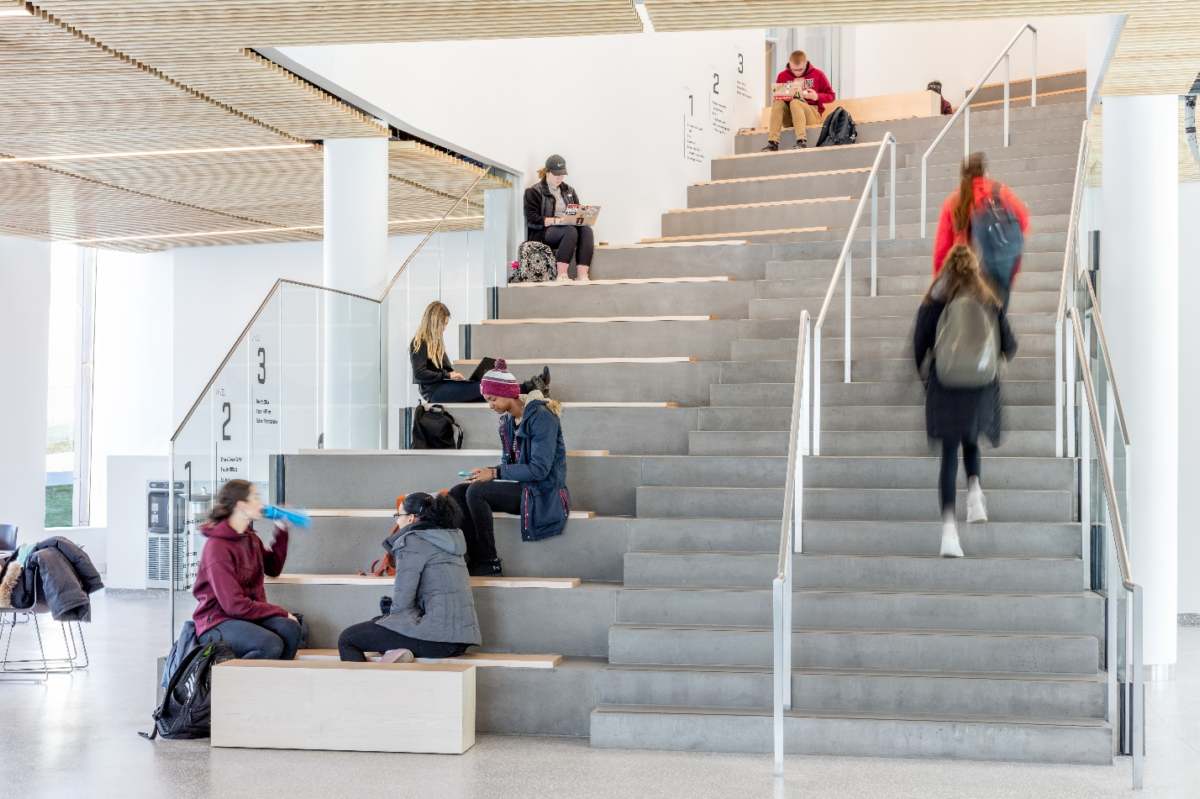 The inner spaces of the extension face a circular courtyard, where an open-air garden and stone benches create an oasis for collaboration and contemplation. The courtyard connects back to the campus via two pathways between the original Isenberg building and the Business Innovation Hub. The buildings are fused by two bridges above the paths: the large bridge cloaked in copper becomes the gateway to the courtyard while the small bridge glazed with glass forms a visual continuity around the interior courtyard.
The inner spaces of the extension face a circular courtyard, where an open-air garden and stone benches create an oasis for collaboration and contemplation. The courtyard connects back to the campus via two pathways between the original Isenberg building and the Business Innovation Hub. The buildings are fused by two bridges above the paths: the large bridge cloaked in copper becomes the gateway to the courtyard while the small bridge glazed with glass forms a visual continuity around the interior courtyard.In the evening, the Business Innovation Hub glows from the life within—appearing as an inviting beacon on the campus and creating a lasting impression for campus visitors, staff and students.
NAME: Isenberg School of Management Business Innovation Hub
SIZE: 70,000ft2 / 6,500m2
LOCATION: Amherst, Massachusetts, USA
CLIENT: University of Massachusetts Building Authority
DESIGN ARCHITECT: BIG-Bjarke Ingels Group
ARCHITECT OF RECORD: Goody Clancy
COLLABORATORS: Richmond So Engineers, Arup, BIG IDEAS, Nitsch, VAV, Towers Golde, Haley & Aldrich, Acentech, HLB, SGH, PEER, WIL-SPEC, VGA, Lerch Bates, LN Consulting, Mohar Designs
Ritningar av Spridds bostadsarkitektur i Norrköping
Svenska
”Väv” är ett flerbostadshus med kommersiella lokaler i bottenvåningen på en centralt belägen tomt i Norrköpings historiska industrilandskap. Projektet är resultatet av vinst i en markanvisningstävling 2012 där Norrköpings kommun hade som mål att förnya det unika och välbevarade industrilandskapet.
Prisbelönad bostadsarkitektur i Norrköpings historiska industrilandskap
”Väv” är ett flerbostadshus med kommersiella lokaler i bottenvåningen på en centralt belägen tomt i Norrköpings historiska industrilandskap. Projektet är resultatet av vinst i en markanvisningstävling 2012 där Norrköpings kommun hade som mål att förnya det unika och välbevarade industrilandskapet.
Ritningar av Spridds bostadsarkitektur i Norrköping...
Foto: Anders Fredriksén, Erik Törnkvist
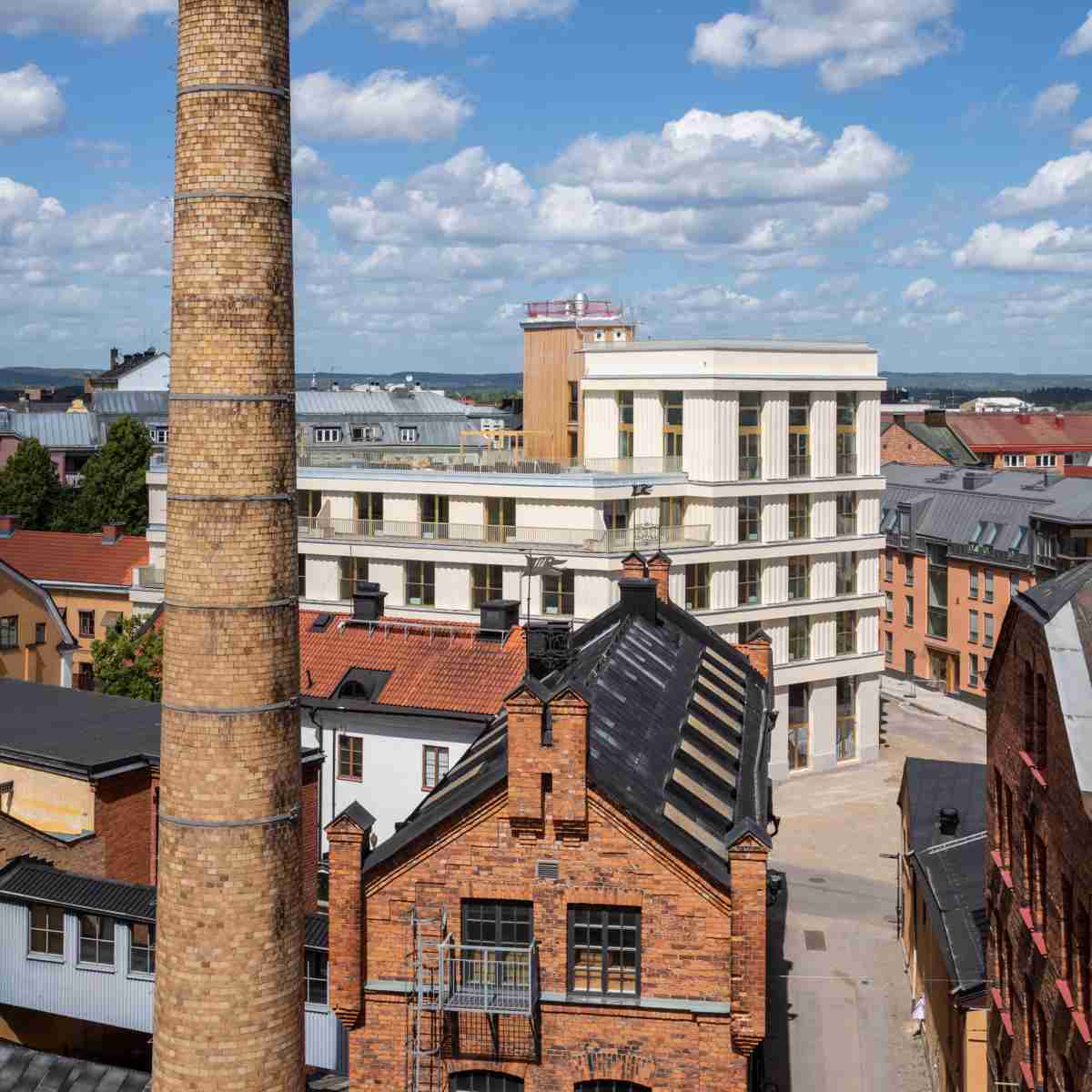 Huset har rönt stor uppmärksamhet och bland annat fått först pris i den internationella tävlingen MIPIM Architectural Review Future Project Award 2013. I stadsplanen fullbordar huset det triangulära stadskvarteret och den nya byggnaden blir en framträdande fond till ett intimt nytt torg intill de publika stråk som leder ned mot centrala delar av staden. Byggnaderna i området som ursprungligen användes av textilindustrin har gradvis gjorts om till kontorslokaler, utbildnings- och kulturinstitutioner och i vissa fall bostäder. I den historiska industrimiljön har studenten ersatt arbetaren. ”Väv” är en del av denna stadsomvandling.
Huset har rönt stor uppmärksamhet och bland annat fått först pris i den internationella tävlingen MIPIM Architectural Review Future Project Award 2013. I stadsplanen fullbordar huset det triangulära stadskvarteret och den nya byggnaden blir en framträdande fond till ett intimt nytt torg intill de publika stråk som leder ned mot centrala delar av staden. Byggnaderna i området som ursprungligen användes av textilindustrin har gradvis gjorts om till kontorslokaler, utbildnings- och kulturinstitutioner och i vissa fall bostäder. I den historiska industrimiljön har studenten ersatt arbetaren. ”Väv” är en del av denna stadsomvandling.
Lägenheterna i huset har olika karaktär. I den dubbelhöga bottenvåningen ryms både kommersiella lokaler och bokaler som kan användas för småskalig verksamhet kombinerat med boende eller t ex. boende med ett ateljérum mot gatan. På de övre planen ryms lägenheter av varierande storlek för såväl studenter som äldre och barnfamiljer. Taklandskapet erbjuder en sekvens av terrasser på olika nivåer med milsvid utsikt över Norrköping.
Förslagets arkitektur slår en båge mellan historien och samtiden och omtolkar en serie karakteristiska teman i industrilandskapet, som stora fönster, lokala torn och en repetitiv och rationellt gestaltad fönstersättning. Byggnadens fasad består av prefabricerade utfackningselement av betong med en storskalig böljande yta som fångar ljusets skiftningar och ger fasaden en textil och föränderlig karaktär. Genomgående franska fönster ger rikligt med ljus och är utformade i guldanodiserad aluminium.
Fakta
Projektets namn: Väv Arkitekt: Spridd och Etat i samarbete Pris: Architectural Review Future Project Award 2013 Plats: Industrilandskapet, Norrköping Typ: Flerbostadshus Byggnadsår: 2016-2018 Beställare och entreprenör: ED Bygg Stomme: Stål och betong med utfackningselement av EPS betong Area: 3475 kvm Illustration: Spridd och Etat
Detail
På byggplatsen Fönsterdetail
Meddelande: Spridd
Der Turmbau - Roman von Oskar Loerke
Der Turmbau
Roman von Oskar Loerke
1. Auflage 2012
Kulturexpress Verlag, Frankfurt am Main
Softcover, 228 Seiten
mit 34 Abb. nach Tuschezeichnungen von R. E. Maass
Format: 19,1 x 13,1 x 1,85 cm
ISBN: 978-398146901-1
Max Dudler Ensemble belebt Schweizer Quartier Bülachguss
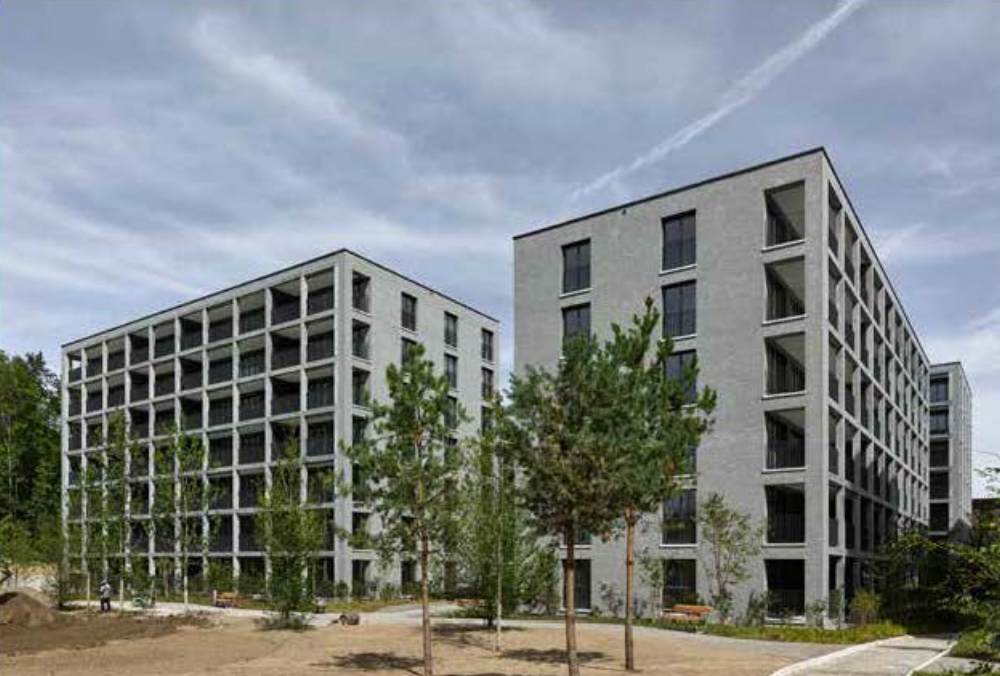 Modular konzipiert setzt sich das städtebauliche Ensemble aus der Wiederholung eines einfachen zeilenförmigen Baukörpers zusammen. Durch punktsymmetrische Spiegelung und Drehung des kubischen Volumens entsteht ein von windmühlenartig angeordneten Baukörpern gerahmter Platz. Die Elemente sind dabei so transformiert, dass die Bebauung sinnvoll auf den städtebaulichen Kontext reagiert. Der langgezogene L-förmige Baukörper im Norden schirmt die Wohnbebauung von der Fangletenstraße ab. Der Innenhof öffnet sich in alle anderen Himmelsrichtungen, sorgt für Licht in den Wohnungen und vernetzt den Ort mit dem Quartierspark und den Wegen, Höfen und Plätzen der Wohnfelder im Osten und Süden. So wird die Stadt Bülach an dieser Stelle bedacht weitergebaut. Es entsteht nicht nur ein Quartier, sondern ein sozial gedachtes, funktionierendes Stück Stadt.
Modular konzipiert setzt sich das städtebauliche Ensemble aus der Wiederholung eines einfachen zeilenförmigen Baukörpers zusammen. Durch punktsymmetrische Spiegelung und Drehung des kubischen Volumens entsteht ein von windmühlenartig angeordneten Baukörpern gerahmter Platz. Die Elemente sind dabei so transformiert, dass die Bebauung sinnvoll auf den städtebaulichen Kontext reagiert. Der langgezogene L-förmige Baukörper im Norden schirmt die Wohnbebauung von der Fangletenstraße ab. Der Innenhof öffnet sich in alle anderen Himmelsrichtungen, sorgt für Licht in den Wohnungen und vernetzt den Ort mit dem Quartierspark und den Wegen, Höfen und Plätzen der Wohnfelder im Osten und Süden. So wird die Stadt Bülach an dieser Stelle bedacht weitergebaut. Es entsteht nicht nur ein Quartier, sondern ein sozial gedachtes, funktionierendes Stück Stadt. Durch bewusst gesetzte Knicke in den Gebäude-Volumen entstehen eindrückliche, skulpturale Baufiguren. Es ergeben sich spannungsvolle Perspektiven, in denen die Linien der Baukörper aufeinander verweisen und die Gebäude zu einem einheitlichen Ensemble gefügt werden. Die Knicke weiten den Raum und sorgen für einladende Gesten, 2/15 durch die der Außenraum ins Innere des Ensembles fließt, von wo die Wohnungen erschlossen werden. Der starke Bezug zum Außenraum am Übergang von Stadt und Landschaft wird auch in den Wohnungen deutlich. Mit ihren über die gesamte Fassadenlänge angelegten Loggien bieten sie den Bewohnern großzügige, am Sonnenstand ausgerichtete Außenflächen. Die Loggien wurden als filigrane, klar gegliederte Raumgitter aus Sichtbeton in die monolithischen Baukörper eigeschoben.
Die klare kubische Form der Gebäude findet ihre Entsprechung in der Reduktion der ausgewählten Materialien und Farbtöne. Der Entwurf setzt die Qualitäten der Werkstoffe in Szene, ihre Haptik und Atmosphäre. In Materialität und Detaillierung nimmt er Bezug auf den denkmalgeschützten Backsteinbau der Bülachguss, der dem Quartier seinen historischen Anknüpfungspunkt verleiht. Aus ihren präzisen Details entwickelt sich die Fassade als subtiles Relief und verstärkt so die skulpturale Wirkung der Gebäude. Die rauen, im Grauton changierenden Klinker verleihen den Fassaden Lebendigkeit und werden kombiniert mit filigranen, scharfkantigen Betonfertigteilen in heller Tonalität. Kontrastierend sind Fensterrahmen, Staketengeländer und sämtliche weiteren Metallteile in anthrazitfarbenem Eisenglimmer gehalten.
Meldung: Max Dudler Presse

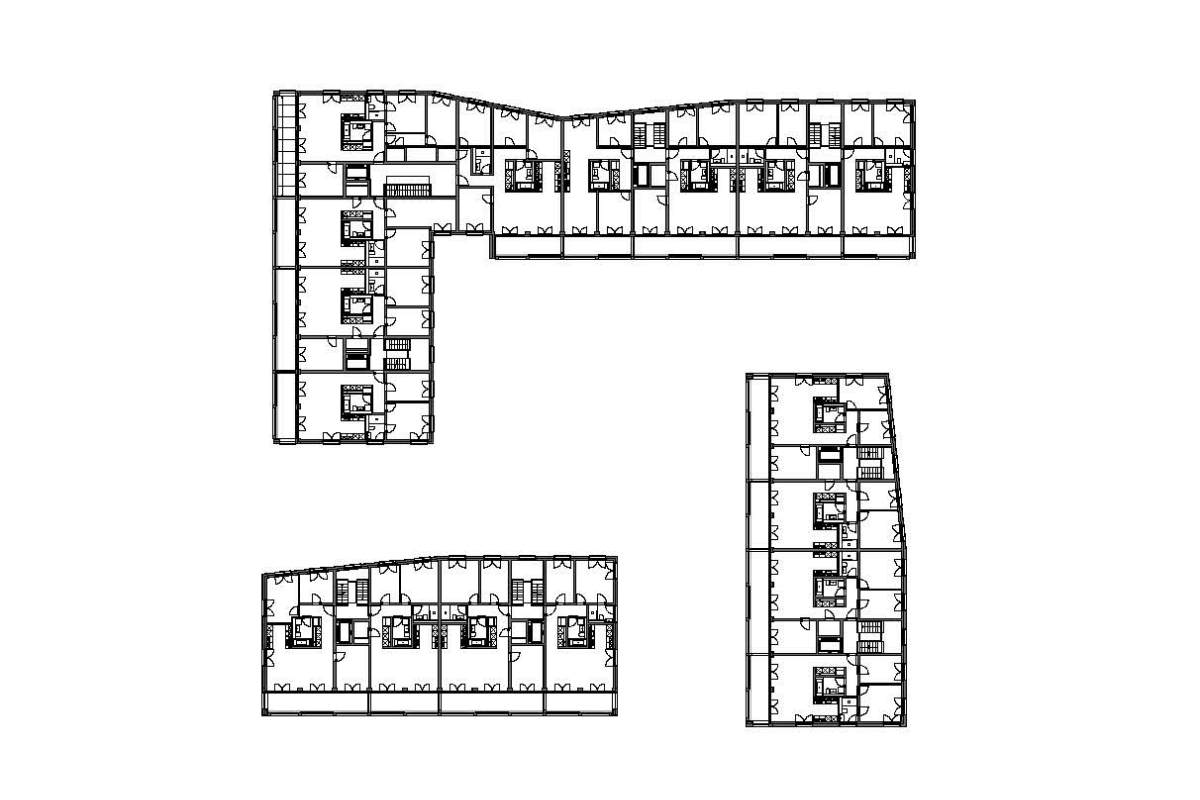
Moderne am Main 1919 - 1933
Moderne am Main 1919 - 1933
Autoren: Klaus Kemp, Annika Sellmann, Matthias Wagner K und Grit Weber
Verlag: avedition, Stuttgart
1. Auflage, 2019
kartoniert, 296 Seiten
zahlr. farbige Abb.
ISBN: 978-3899863031
Größe: 16,7 x 2,7 x 24,2 cm
Rethinking Wood
Rethinking Wood
Future Dimensions of Timber Assembly
Hrsg. v. Markus Hudert und Sven Pfeiffer
Birkhäuser Verlag, Basel
1. Auflage, 2019
gebunden 256 Seiten,
60 farbige Abb.
Sprache: Englisch
Größe: 18.5 x 27 cm
Architektur und Literatur
Architektur und Literatur
Hrsg. Rolf E. Maaß
Edition Arkitek (Kulturexpress Verlag)
1. Auflage 2018, Frankfurt am Main
Sachbuch, broschiert, 48 Seiten
ISBN: 978-3-98146909-7
Flächen und Rauminhalte
Flächen – Rauminhalte
DIN 277 und alle relevanten Richtlinien – Kommentar, Erläuterungen, Bildbeispiele
Herausgegeben von Bert Bielefeld und Peter Fröhlich
Springer Vieweg Verlag, Wiesbaden
17. Auflage, 2019
gebundene Ausgabe, 155 Seiten
17 s/w Abb. u. 76 Abb. in Farbe
Größe: 16,8 x 24 cm
ISBN: 978-3658209087


